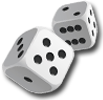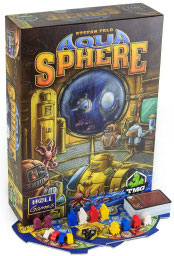



play board games
Board game reviews, strategy tips & session reports
AquaSphere Board Game Review
 Stats:
Stats:
No. of players: 2-4
Amount of time to play: 90-120 min
Age requirements: 12+
Set-up time: 5 min
AquaSphere is a worker placement game in which you are a scientist studying in an undersea lab. Can you utilize your time better than your opponents and score more knowledge points?
AquaSphere Rules Description:
AquaSphere has two main boards. One is the Headquarters and the other is the Research Station.
You move your Engineer in the Headquarters to program bots. Then your Scientist tells the bots where to perform their function in the Research Station.
You start the game with your starting Lab, some Time Markers (the game’s main resource) and one programmed bot. On your turn you program a bot, carry out an action with a programmed bot or pass.
To program a bot you move your Engineer in the Headquarters to the next space along an arrow. Each space has two arrows exiting it and choosing one space may not allow you to visit others. You then place a bot from the supply area on your Player Board in the matching programmed area there. You may never have more than two programmed bots. Also once per round you may program a bot for three Time Markers.
Taking actions in the Research Station requires programmed bots. You can program a bot to do the following, expand your Lab, take Time Markers, take crystals, catch octopods, place a submarine, take a research card or to program a bot. You can spend Time Markers to move to the sector you want the bot to perform the action in. After taking the action the bot was programmed for, you place that bot in the center of the sector. If it is already occupied you push the previously placed bot out of the sector.
When you expand your Lab it increases your capacity to hold resources, resource cards, and catch octopods. It can also gain you lots of VP at the end of game scoring. Each letter from A-F in our Lab at the end of the game scores you extra knowledge points which I am going to call Victory Points(VPs). When you build a Lab tile with a letter on it you also place a bot in that sector.
You can only gain as many Time Markers or crystals as marked on your Lab. You spend Time Markers to move between sectors and crystals to be able to score points. Octopods in sectors you control lose you VPs. To remove them you must program a bot to catch them.
You may place one submarine in each sector and costs Time Markers. The cost is based on the number of submarines already there and scores you two to five VPs depending on the round.
Research cards grant you bonuses that occur instantly, between rounds or when you take a specific actions or movements. For example one research card gets you two Time Markers every time your Engineer programs a bot to catch octopods.
Programming a bot to program a bot is a bit less straightforward. Each sector has one of the first six actions associated with it. The action you get from a bot programmed to program another bot depends on the sector your Scientist is in.
Once your Engineer is at the top of the Headquarters you may pass. Once all players have passed the round is over. Between rounds you score VPs and add more Time Markers, crystals, octopods, lab extensions and research cards to the Research Station. You also rearrange the program tokens in the Headquarters. This keeps the programmable actions from happening in the same order every round.
During intermediate scoring you gain Time Markers based on the number of submarines you have placed. Then you sum the following: if you have bots in the most sectors you gain six VPs, then you gain VPs based on the number of bots you have out, crystals you have and subtract VPs based on the number of octopods in the sectors you have bots in.
After four rounds (and a final intermediate scoring round) the game ends. Next is the final scoring. You score 1 VP for each Time Marker you have, 5 VPs if you placed all six of your submarines, 5 VPs if you completed your lab (with 5 lab extensions) and between 1 to 21 VPs for the number of different letter in your lab.
Quick Review of AquaSphere:
AquaSphere is a fairly complicated, two-tiered worker placement game. You are limited to certain actions and only being able to hold a certain number of resources.
The components for the game are great. The art is good, icons make sense and the octopod tokens are great. The rules are well written and have plenty of examples.
I like how modular this game is and how the amount of variety adds a ton of replay value to it. From the center tiles that determine what you place in the sectors between rounds to the order of the action tokens in the Headquarters this game has a lot of things that may change from game to game.
Like most worker placement games you cannot just concentrate on one thing. You need to be able score VPs in a variety of ways I you want to win.
This game is a brain-burner. I really enjoy worker placement games and have played many but this one is pretty unique. It is very tactical and you won’t be able to get to do all the things you want to in a round. You must read the situation and make the most out of the current state of the game. You can plan some but other players or limitations can get in your way.
Be aware you are going to spend the first three or four games figuring out how AquaSphere works and just how many things you can realistically get done. And that can be frustrating. There are just so many moving parts in this game it is going to take a few plays before you are more comfortable.
AquaSphere has moments when your plan works and it is exciting, but it can also be frustrating. There is a lot going on and you need to keep track of a good bit of stuff. Take baby steps and don’t get too ambitious early and you’ll do better while learning the game. For me the amount of fun does not outweigh the amount of work this game is. I think others will disagree with me but my head was spinning after the first couple plays. Things did get easier, but it was still too much for my noggin’. I would play it if you asked me but I am not sure I’d suggest it. I think you should try it before you buy it.
Score and synopsis: (Click here for an explanation of these review categories.)
Strategy 4 out of 6
Luck 5 out of 6
Player Interaction 4 out of 6
Replay Value 6 out of 6
Complexity 6 out of 6
Fun 4 out of 6
Overall 4 out of 6

Leave a Reply